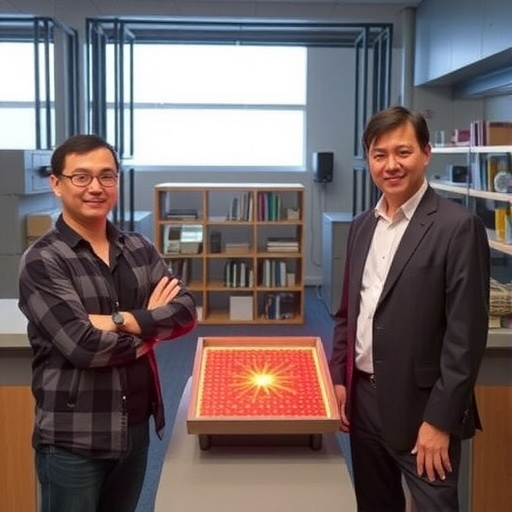In a groundbreaking advancement that could revolutionize the field of renewable energy, researchers at the Queensland University of Technology (QUT) have developed an innovative material capable of converting waste heat into electricity with unprecedented efficiency. This discovery has significant implications for energy sustainability as it addresses a critical issue: the vast amounts of waste heat generated by vehicles, industrial processes, and power plants that are otherwise lost to the environment.
The research team, led by the esteemed Professor Zhi-Gang Chen and Dr. Xiao-Lei Shi from QUT’s School of Chemistry and Physics, has successfully engineered a new thermoelectric material by incorporating manganese into silver copper telluride. This seemingly small alteration has resulted in a material that outperforms all previous candidates in its category, marking a significant milestone in thermoelectric technology.
The study’s findings, articulated in the journal Energy & Environmental Science, reveal that the newly developed material achieves record-high thermoelectric performance. This is particularly notable as thermoelectric materials are typically limited in their efficiency, often converting only a fraction of available heat energy into electricity. Through rigorous experimentation, the researchers demonstrated that the manganese-doped silver copper telluride achieved a conversion efficiency of over 13 percent when integrated into a prototype device—a number that places it among the leading technologies currently available.
This level of efficiency is astonishing, especially when considering that traditional thermoelectric materials usually hover around a few percent efficiency. Professor Chen explains that in practical terms, this means that for every 100 units of heat energy applied to the device, approximately 13 units are successfully transformed into usable electricity. While it may seem modest, this represents a considerable advancement for thermoelectric applications, opening the door to enhanced energy recovery systems.
One of the most compelling aspects of this research is its potential to contribute to the global energy landscape significantly. As noted by Professor Chen, immense quantities of heat generated from everyday sources such as automobiles, manufacturing plants, and electrical generation facilities are wasted every day. This innovative material holds the promise of capturing some of that energy, transforming it from a lost resource into a clean electricity source, thereby supporting a shift towards renewable energy solutions.
Beyond its impressive efficiency, the team highlighted the environmental advantages of their new material. Associate Professor Shi pointed out that the manganese-infused compound does not contain toxic elements, unlike many alternative thermoelectric materials. This stability and the simplicity of its production processes suggest that it is not only effective but also potentially scalable for real-world applications, making it a prime candidate for widespread utilization in various sectors.
The potential applications for this technology span a variety of industries, from automotive to manufacturing and energy production. By integrating this thermoelectric material into existing systems, industries could harness waste heat that would otherwise be vented or dissipated, converting it into a valuable energy source. This conversion could significantly bolster energy efficiency and sustainability efforts across multiple sectors, contributing to global carbon neutrality goals.
As part of their research, the team built a prototype device to validate their findings. The experimental setup was crucial for testing the practical application of the new material and ensuring that its high efficiency could be replicated in a functional device. The results exceeded expectations, leading the researchers to conclude that this technology could soon transition from laboratory research to practical applications in the real world.
The collaborative nature of this research project was evident, with significant contributions from a diverse team of scientists and professionals within QUT. Each team member brought unique expertise to the initiative, ensuring that various aspects of material development, experimental testing, and theoretical analysis were thoroughly addressed. This multifaceted approach is critical in addressing the complex challenges associated with thermoelectric materials and enhancing their practical applicability in energy conversion technologies.
Given the urgency surrounding climate change and the need for innovative energy solutions, the results of this study are timely and impactful. Transforming waste heat into usable energy represents not just a technological breakthrough but also a strategic pathway towards reducing overall greenhouse gas emissions. In a world increasingly focused on sustainability, the demand for effective energy conversion solutions has never been greater, and this research provides hope for more efficient and eco-friendly energy systems.
As the study is published and disseminated within the scientific community, it is expected to generate considerable interest and spur further investigations into the applications of manganese-doped thermoelectric materials. Researchers and industries alike will likely explore the broader implications of the findings, considering how this new material could integrate with existing technologies and infrastructure to enhance energy recovery and efficiency.
In conclusion, the pioneering work done by the QUT research team not only underscores the importance of scientific innovation in tackling global energy challenges but also highlights the potential for simple modifications in material composition to yield remarkable improvements in performance. This development might just be the catalyst needed to turn the tide in energy efficiency and sustainability, showcasing the profound impact that research can have on our quest for a greener and cleaner future.
Subject of Research: Thermoelectric performance of manganese-doped silver copper telluride
Article Title: Manganese doping induced record-high medium-temperature AgCuTe thermoelectrics
News Publication Date: August 28, 2025
Web References: https://doi.org/10.1039/D5EE02875B
References: Energy & Environmental Science
Image Credits: Credit: QUT
Keywords
Thermoelectric materials, energy conversion, waste heat utilization, renewable energy, manganese doping, QUT research, sustainability, carbon neutrality, energy efficiency, industrial applications.
Tags: electricity generation from waste heatEnergy & Environmental Science publicationenergy sustainability solutionshigh-efficiency thermoelectric performanceindustrial waste heat recoveryinnovative thermoelectric materialsmanganese-doped silver copper tellurideProfessor Zhi-Gang Chen researchQueensland University of Technology researchrenewable energy advancementsthermoelectric technology breakthroughswaste heat to energy conversion





